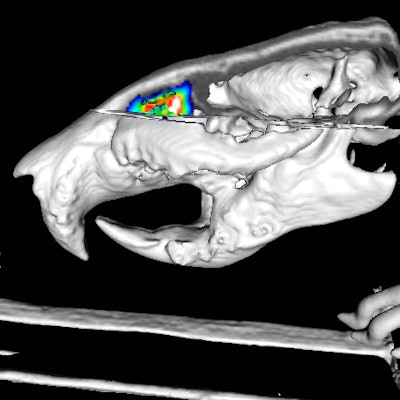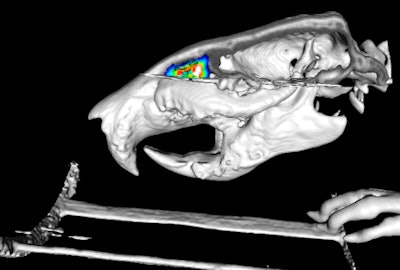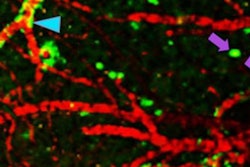
Backed by previous research suggesting that losing one's sense of smell can be a sign of neurodegeneration, researchers are developing a novel PET imaging agent that targets olfactory neurons to assess the extent of disease, according to a study published online January 23 in the Journal of Clinical Investigation.
Olfactory neurons are located in the nasal cavity and continuously regenerate throughout an adult's life. This process can be disrupted due to neurodegenerative disease, which could make olfactory dysfunction an excellent marker (JCI, January 23, 2017).
 Jacob Hooker, PhD, from Massachusetts General Hospital and Harvard School of Medicine.
Jacob Hooker, PhD, from Massachusetts General Hospital and Harvard School of Medicine.So far, the PET radiotracer GV1-57, also dubbed Neurolux, has shown promise by localizing to the mature neurons in the olfactory epithelium of animals. With this success in preclinical trials, researchers have taken the imaging agent to humans for initial evaluation.
"The hypothesis is: As you start having neurodegeneration, this cell population may be very vulnerable and it may be an early marker of disease," explained Jacob Hooker, PhD, lead developer and research scholar at Massachusetts General Hospital. "We also think it would help us understand drug trials in which people are trying to rescue olfaction therapeutically, and it might give us a marker to look at the regeneration of these mature neurons as a predictor of whether smell would be regained over time."
Olfactory forecasts
There is evidence supporting the clinical value of olfactory sensation in predicting mortality, assessing one's quality of life, and detecting neurological conditions such as Alzheimer's disease and traumatic brain injury. One notable study indicated that the loss of the sense of smell and olfactory dysfunction can be a predictor of five-year mortality.
"Olfactory dysfunction was an independent risk factor for death, stronger than several common causes of death, such as heart failure, lung disease, and cancer, indicating that this evolutionarily ancient special sense may signal a key mechanism that affects human longevity," Pinto et al wrote in a 2014 study in PLOS One.
"It is profound what happens to people in correlation to the loss of the sense of smell," Hooker said. "It is not uniform to everyone who develops the diseases, but it is prevalent in the 10% to 20% range, perhaps more, depending on the disease."
Serendipitous discovery
As happens sometimes in research, initial expectations and goals lead to unintended discoveries. So how did this PET imaging agent come to be?
"Serendipity," Hooker quipped. "We had this goal of going after a marker that would relate to overall brain synaptic plasticity or neurogenesis. Those are two hallmarks of brain health that we would like to be able to measure in humans."
But in the course of testing Neurolux for this application, they encountered some unanticipated results.
"Time and time again we found ourselves with this unique signal, which we could not ignore, within the olfactory epithelium," added Hooker, who also serves as an associate professor of radiology at Harvard Medical School. "What got us excited about the signal were the olfactory sensory neurons that are within this tissue, their life cycle, and how they respond to health in general."
The unique olfactory epithelial signal from Neurolux achieved "great signal-to-background" ratio, he added, and lit up in the brains of animal subjects like a "beacon" in preclinical trials.
 The PET/CT image illustrates the PET tracer in the olfactory epithelium after injection into a rat. The signal volume and intensity (colored area) represent the mature olfactory neuron population, which can be used to assess neurodegeneration and neuroregeneration as a function of normal processes or disease. Image courtesy of Jacob Hooker, PhD.
The PET/CT image illustrates the PET tracer in the olfactory epithelium after injection into a rat. The signal volume and intensity (colored area) represent the mature olfactory neuron population, which can be used to assess neurodegeneration and neuroregeneration as a function of normal processes or disease. Image courtesy of Jacob Hooker, PhD.After evaluating Neurolux in preclinical trials on mice, rats, and two species of nonhuman primates, researchers now are preparing the groundwork for human studies. The U.S. Food and Drug Administration (FDA) gave the green light to proceed after approving the company's investigational new drug (IND) application in mid-2016.
"We have not moved into more disease-relevant patients yet until we get a good handle on how to quantify and interpret the [radiotracer's] signal," Hooker said.
In an editorial that accompanied the JCI article, Dr. Helene Benveniste, PhD, a professor of anesthesiology at Yale University School of Medicine, wrote of the exciting potential of the radiotracer.
"To our knowledge, GV1-57 is the first PET radiotracer that can identify and quantify a specific neuronal subtype, irrespective of the neuron's functional state," she wrote. This "tracer and, likely, its successors have the potential to serve as biomarkers for trauma, toxicity, and neurodegeneration, as well as reporters for therapeutic development."



















